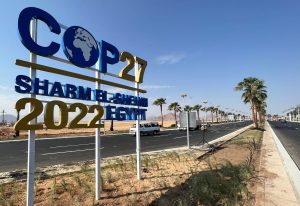
COP-Out 27: From emission cut goals to climate fund, nothing is a game changer

In all honesty, it is difficult to see the 27th Conference of Parties to the United Nations Framework Convention on Climate Change — COP27 for short — which concluded at Sharm El-Sheikh, Egypt, in the early hours of this Sunday (November 20), as anything but a failure.
India must champion a tech race to build ever cheaper ways to capture carbon dioxide (CO2) from the atmosphere and use it as the starting block of a new petrochemical industry — removing large amounts of CO2 from the air is the only way to prevent global temperatures rising further.
Also read: India-backed ‘loss and damage fund’ gets the green signal at COP 27
Of course, we are measuring the COP27 outcome against the goal of reducing greenhouse gas emissions 43 per cent below the levels reached in 2019, the reduction to be achieved by 2030, if the global temperature rise is to be contained below 1.50°C above pre-industrial levels. This is the best scientific estimate of the magnitude of the task at hand.
In the year since COP26
On this, COP27 has little to offer. Since COP26, which concluded on November 12 last year and had boldly decided to phase down coal, with India opposing ‘phase out’, the use of fossil fuels has gone up significantly, not just in the usual developing country delinquents China, India, Indonesia and South Africa but also in the ardent climate champions of Europe, thanks to the Ukraine war and Europe’s decision to boycott Russian gas and oil, forcing them to not just import gas from elsewhere in the world but also to burn more coal and its dirtier cousin, lignite, in large quantities.
So, a proposal to phase down all hydrocarbons failed to find mention in the final decision of COP27.

Europe is investing massively in new plants to regasify liquefied natural gas (LNG) at new import facilities to berth and unload huge LNG tankers, as it extricates itself from dependence on Russian gas. Russian gas flows into Europe via pipelines. A boycott of Russian gas thus imposes two kinds of additional infrastructural cost on Europe: the cost of building new LNG infrastructure, and the cost of forgoing sunk cost on pipelines from Russia.
This, naturally, is in addition to the cost of the LNG imported from non-Russian sources: the US, the petro-states of the Middle East, to which Israel and Lebanon will soon add themselves, and Africa.
LNG is, of course, more expensive than natural gas, which flows relatively inexpensively through pipelines and does not, unlike LNG, have to be cooled under pressure, stored in cryogenic containers and shipped in specialised tankers, requiring dedicated berths with equipment for converting the liquid back into gas.
So, Europe is undergoing a step change in the cost structure of its energy. It would be loath to write off its investments in LNG infrastructure by agreeing to phase down hydrocarbons in a hurry.
Also read: Indian moms join global fight for children’s right to clean air
As it is, simply reducing emissions has little hope of halting climate change. Now, with Europe locked into ‘low-carbon’ natural gas, with fresh investments in LNG, shifting emphasis to carbon dioxide removal (CDR) becomes ever more important. When power is produced from natural gas instead of coal, emissions come down by half. But the other half will keep pouring out.
Net emissions must turn swiftly negative, much in advance of 2050, to achieve the Paris Accord goal of limiting the temperature rise to 1.5°C, and this calls for CDR. This challenge did not get much attention at COP27.
Limiting methane emissions
A positive outcome at COP27 has been to put even more stress on curbing methane emissions. Methane is the principal constituent of natural gas, which contains, besides, bits of ethane, propane, butane and pentanes, as also water vapour. It is tens of times more potent, as compared to CO2, when it comes to warming the atmosphere, but only during its first 10 years in the atmosphere. After that, it oxidises and produces CO2, adding to the stock of the stuff in the atmosphere. CO2 stays on in the atmosphere and does more cumulative damage.
Watch | COP27: Decoding where the world and India stand in acting on climate change
Methane is produced when oil fields neglect to capture the associated gas that escapes when oil is pumped out, when gas pipes leak ,when rice paddy is cultivated using flood irrigation, and when the millions of cattle bred for meat and milk belch and excrete dung.
And through the new shift to LNG, and the longer use of methane it locks in, it becomes all the more important to spot methane leaks and plug them, and to adopt crop and animal husbandry practices that reduce methane emissions. Satellites can spot methane emissions efficiently, but it did not call for a COP to focus attention on this capability.
Small win for Global South
The single biggest achievement of COP27 that is being touted by professional climate activists from the developing world — the Global South, in the parlance currently in fashion — is the decision to set up a fund to compensate developing countries for the loss and damage they have sustained as a result of climate change, to bring about which they have done little.
Also read: COP27 ends with historic compensation fund; delivers less on other issues
The loss and damage fund is meant to help the most vulnerable developing countries to cope with the effects of climate change — relief and rehabilitation after floods and displacement, destruction of established crops, submergence of islands, etc. It overlaps with climate adaptation, climate resilience and other climate-prefixed desirables. In other words, it is conceptually vague.
What is vague about the notion that the rich world that grew rich by producing the bulk of the 2,600 Gigatonnes of CO2 that has warmed the planet since the mid-19th century should help developing countries, which have contributed very little to this CO2 load, cope with the after-effects of global warming?
If the rich world is willing to find enough resources to produce negative emissions on a massive scale, fund climate adaptation and resilience and then find supplementary funds for loss and damage, it would be just great. But the rich world has been falling short on all its climate commitments, including on promises to transfer $100 billion to the developing world as climate finance. Any ambition to thrust further climate greatness on the rich world would serve as a classic example of great expectations.
Also read: India at COP27: Small players need access to tech, just like big ones
From the perspective of halting further global warming, it makes sense to ask the rich world to spend every penny of its climate budget on producing maximal negative emissions as early as possible.
Damage funds vs aid budgets
And there is a fundamental problem in the proposition that the developing world got just a raw deal when the rich world grew rich at the expense of the planet’s health. The rich world also produced the scientific and technological revolution, the advances in medicines and healthcare, in governance and laws, the systems of production, replicating which, developing countries have pulled billions of their citizens out of the wretchedness of subsistence poverty, that have immensely benefited all of humanity, including the Global South.
So, if the developing world insists on a loss and damage fund, the rich nations of the world are likely to reconfigure their existing aid budgets and climate funding and club them all together and stuff them all into a new loss and damage fund. And they want big developing countries like China and India to contribute to the fund.
But we get ahead of ourselves. So far, the decision has only been to set up a committee, sorry, a transitional committee, to look into the creation of a funding mechanism and, separately, bless their generous and bureaucratic hearts, a fund, to address loss and damage.
The fund is an unusual entity. It is and, at the same time, it is not. If the loss and damage fund had been around when Schrodinger was looking around for examples to illustrate his dissatisfaction with a version of quantum mechanics, he would have simply pointed to the fund, and spared the cat its unpleasant fate inside a sealed box containing a capsule of poison that might or might not be released, depending on a subatomic event happening or not happening.
At least in solidarity with the cat, let us hail this solitary achievement of COP27, the setting up of a transitional committee that might or might not, at some point in the space-time continuum, identify a funding mechanism and, possibly, a fund, to address, as well as respond to, loss and damage sustained by the most vulnerable developing countries.
(TK Arun is a senior journalist based in Delhi)
(The Federal seeks to present views and opinions from all sides of the spectrum. The information, ideas or opinions in the articles are of the author and do not necessarily reflect the views of The Federal)


